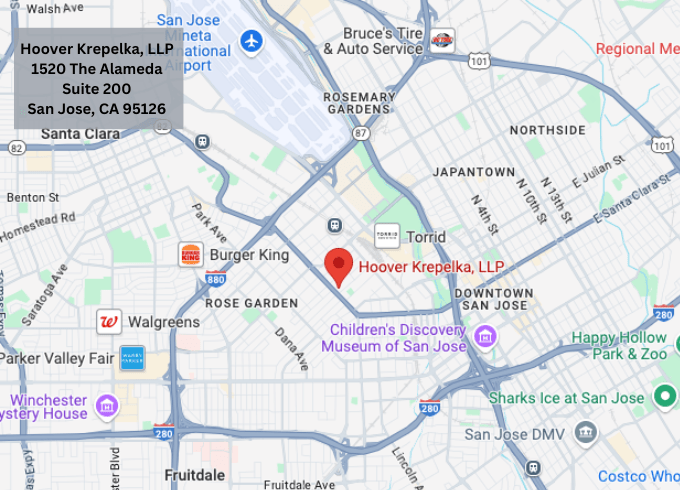
By Jim Hoover, Partner & Certified Family Law Specialist, Hoover Krepelka, LLP
Schedule of assets and debts? Income and expense declarations? Demands for production of documents, form interrogatories, oral depositions, third-party subpoenas for records? What are these? None of these were exchanged in our vows at the altar, so why now? This is worse than that loan application!
It is because while the love and the vows are now but memories, you were and remain a legally recognized partnership, a union of once indivisible physical, emotional, and financial contributions that is now to be dissolved. Dissolution requires the determination of one’s rights and responsibilities in financial matters. Thus, those in such a partnership must honor fiduciary duties of, among many others, disclosure of all financial affairs.
In fact, the California Family Code explicitly states that these fiduciary duties between spouses are the “same rights and duties of nonmarital business partners, as provided in [ ] the California Corporations Code. . .” Cal. Fam. Code Section 721, referencing Cal. Corp. Code Sections 16403, 16404, and 16503. The same fiduciary duties between majority and minority shareholders of a corporation, between owners of a business to each other, apply to a married couple who once shared the same bed if not pillow!
But, you didn’t know that at the altar, right? Your duties of financial disclosure took a very distant seat from what was really on your mind: honeymoon and mother-in-law politics.
Now, shouldn’t the dissolution of this “partnership” be easy? After all, how did the marriage occur, and can we not just reverse that and go our own ways?
Understanding The Divorce Process
A couple marries by (i) obtaining a marriage license from the county recorder’s office; (ii) solemnizing their marriage in any manner they choose, so long as it loosely follows the guidelines of Cal. Fam. Code Section 400 et seq.; and (iii) thereafter, the license is returned to the county recorder’s office so that it becomes a marriage certificate.
One would think a divorce means the couple simply returns the marriage certificate to the county recorder’s office and obtain a certificate of “non-marriage” or “divorce” or some equivalent. But that is not the case. It’s a lawsuit and for a reason.
When spouses divorce, they must address their rights and responsibilities as to financial matters. What are those financial matters? In general, they include but are not limited to spousal support, alimony, maintenance, child support, asset and debt identification, characterization, valuation and division, attorney’s fees and costs, reimbursement claims, and breaches of fiduciary duties.
Often this is captured in a summarized matrix or spreadsheet, including who is awarded what asset/debt at what value, and thereafter including possible spousal/child support arrears, spousal support buyout, reimbursement claims, Watts/Epstein reimbursement claims, breaches of fiduciary duties, attorney’s fees and costs, with a resulting equalizing payment owed from one party to another.
Understanding Finances Within The Divorce Process
We drill deeper into these financial matters, such as determining separate/community property tracing and/or community reimbursements, including: (i) straight and/or hybrid separate/community property tracing; (ii) “Nelson” or “Hug” analysis of community and separate interests in vested/vesting stock, RSU, stock options; (iii) “Moore-Marsden” community interests, if any, in separate real property; (iv) “Van Camp” or Pereira” analysis of community interest, if any, in separate property businesses; and (v) general reimbursement claims such as fair rental value.
(You can blaze through some of this stuff. I’ll tie it all together below, promise.)
Further within the divorce process, we must address post-date of separation accounting, including: (i) use of community funds for community or separate purpose and charges of same; (ii) use of separate funds for community purpose or other spouse’s purpose and credits for same; and (iii) other accounting.
Understanding Spousal and Child Support
But wait, there’s more to the divorce process! We must address spousal support and child support, including but not limited to:
- determination of income available for support as follows:
- (a) earned income (base, bonus and equity compensation and characterization of community/separate aspect of same) available for support;
- (b) other taxable income from investments/rents/other sources;
- (c) imputed income based upon earning capacity (ability and opportunity to work, impediments to work and employment market);
- (d) imputed income based upon reasonable rate of return on investable assets;
- (e) imputed income based upon receipt of funds into bank accounts; and
- (f) imputed income based upon reduced need or third party paying the expenses of the other party;
- characterization of base/bonus/equity income (RSU/ESSP/stock options) as separate property (income available for support) or community property (asset to be divided);
- support arrears: “true up” wherein obligor owes more, or “claw back” wherein obligee owes back;
- Dissomaster generation as to guideline support and inputs for same; (v) Ostler-Smith (a certain percentage of income greater than base) additional bonus support “true up”;
- long term spousal support: analysis/computation of Marital Standard of Living (either income or expense approach) as cap on support, or “top down” approach on support, and other factors;
- long term spousal support: alternative support calculations based upon 60%/40%, 55%/45%, 50%/50% shared net income (“share the pain” method); and
- tax implications of all of the above.
That’s a lot! And we cannot forget the analysis of the tax implications of all of the above.
How Can Our Divorce Attorneys Help With Your Divorce Process?
So how do you determine your rights and responsibilities to the above, and what is our role in education, advocacy, and acting in your best interests? We apply the law, our experience, expertise, and common sense to the facts.
The facts. If you read this far, thank you, and finally, we come full circle to the fiduciary duties of disclosure! The California Legislature and Judicial Council determined that the modicum, minimum threshold for satisfying one’s fiduciary duties of disclosure of financial matters is through the Income and Expense Declaration and Schedule of Assets and Debts. These are forms that you can look up on the internet.
Regardless of how amicable or antagonistic a divorce is, the full completion of these forms and service of same in a “Preliminary Declaration of Disclosure” and thereafter “Final” or waiver of same, is mandatory. You cannot get divorced without service and filing of service of same. Now, it is up to you or your counsel to “police” the quality and thoroughness of the other’s disclosures. From these disclosures, you very well may be able to determine all of your aforementioned rights and responsibilities. But often, you need to drill a bit deeper through discovery and due diligence.
And, it is up to you whether you wish to conduct more due diligence and discovery, as said disclosures may only be the beginning. You may propound informal discovery, or formal discovery, as stated above. I realize that I’m likely over my “word count,” so I’ll share my thoughts on the same in a further post.






